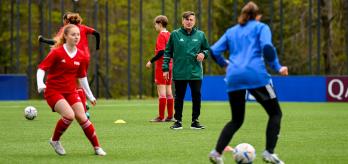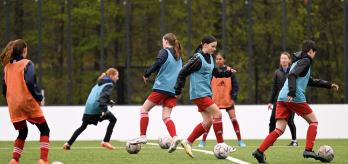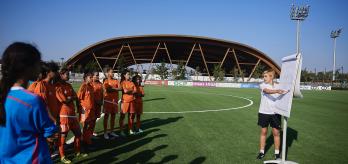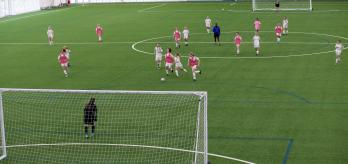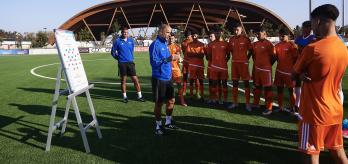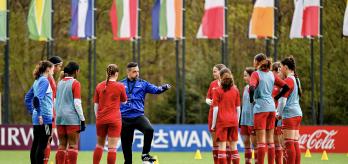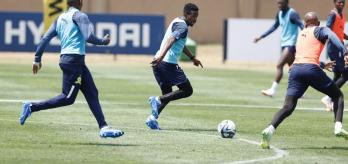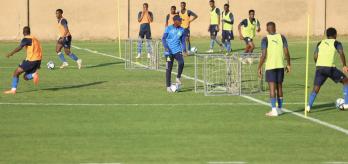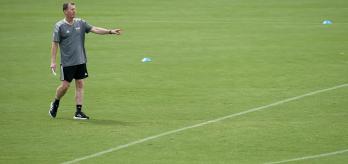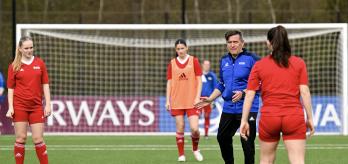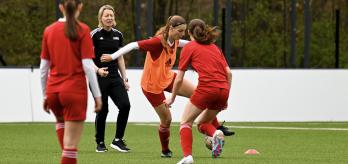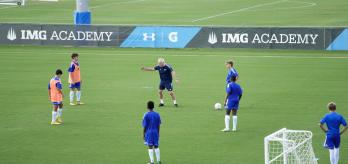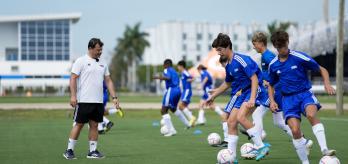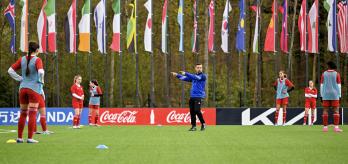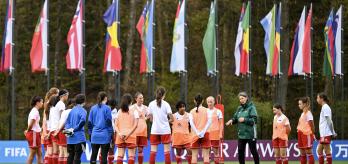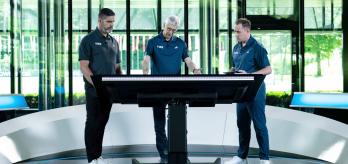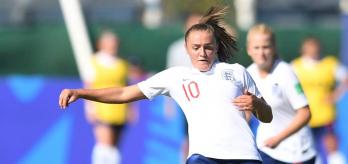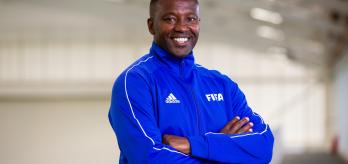To train the attributes required for vertical progressive play, Michel Renggli, youth development coach at FC Luzern and former pro player from Switzerland, provides a session for a group of young players that consists of four tailored drills: a technical activation in the form of a passing exercise, a 10v1 unopposed passing practice, an 11v11 in a three-zone octagon, and lastly, an 11v11 game with defensive constraints. Each drill helps cultivate the key principles required to break lines and play forward.
Session overview
- Part 1: passing circuit.
- Part 2: unopposed 10v1.
- Part 3: 11v11 in a 3-zone octagon.
- Part 4: 11v11 with defensive constraints.
Key coaching points
- Practising vertical passing sequences and then applying them to open-play situations.
- Building triangles between opposition lines.
- The movement and coordination of players involved in a passing sequence.
- The ability to find the open player when passing the ball.
This training session was designed with a specific game situation in mind. What tactics and techniques can the team in possession use to play vertical, break through their lines and create chances? The overarching aim is to improve players' passing game and help them progress vertically into the final third.
Part 1: Passing circuit
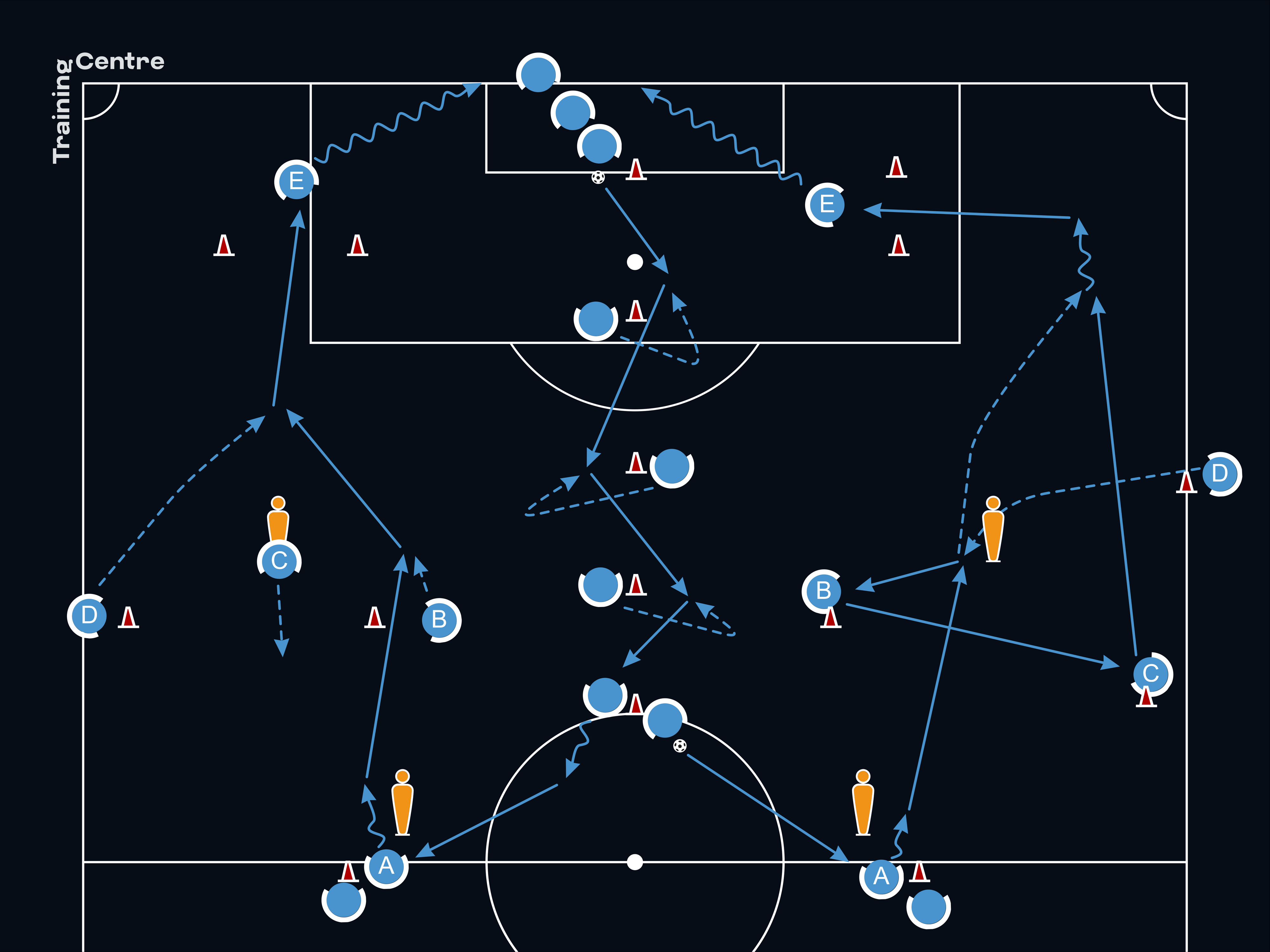
With no opposition pressure, this exercise allows players to concentrate on their passing technique and positioning skills: offering a passing option, receiving the pass and turning to quickly continue the play by passing forward with the right tempo and precision. In order to progress dynamically up the pitch as a team, it is important to find a good rhythm based on clear communication, combination play and synchronised movement.
-
Set up three passing patterns as shown in the image.
-
Distribute three players at the central starting point, two players at the starting points with mannequins, and one player at all other cones.
-
The player at the central starting position begins the sequence by passing to their team-mate at the first cone.
-
To receive the ball, the player takes a quick step away from the first cone and adopts an open body position.
-
They then control the ball, moving it forwards with their first touch, and pass it on to the player next in the sequence.
-
This process is repeated until the player at the last cone in the central pattern receives the ball.
-
Players at the last cone alternate between passing to the starting player at the right and left passing sequences.
-
On the right side, A moves past their mannequin and passes to D, who pulls inside from the wing to lay the ball off to B. B plays horizontally to C, who then plays a through-ball for D to run on to. D completes the sequence by passing to E.
-
On the left side, A receives the ball and dribbles past their mannequin and passes to B. During this time, C makes a dummy run towards A to imitate offering for the ball. B plays a diagonal forward pass for D to run on to, who, once receiving the ball, finishes the sequence by passing to E.
-
Passes from the middle zone to A can now be played in different styles (lofted, drilled, etc.).
-
Players should ensure that their passes are precise and well-weighted.
-
The movement to receive a pass should be well-timed.
-
Clear communication between players and anticipation are needed to synchronise movements and to carry out the sequence as smoothly as possible.
-
To progress vertically more efficiently, players in the central pattern should open themselves up before receiving and bring the ball forward with their first touch.
-
The rhythm of the right pattern should be fast-flowing and culminate in a well-weighted vertical ball into space for D to run on to.
-
Players should learn the right timing for up-back-through combinations
-
Players should be aware of teammates movements to get the right timing for counter movements.
Part 2: 10v1
In this exercise, players practice circulating the ball in a 4-3-3 formation with the defensive midfielder between the two centre backs, looking for different ways of creating chances through vertical play. Good timing and execution are critical for both passers and receivers, and all players need to work together in a coordinated way.
Organise 10 players in a 4-3-3 formation on the pitch and a goalkeeper up against them.
-
The sequence starts by the defensive midfielder dropping between the centre-backs.
-
Three patterns are practised:
Pattern 1
-
the defensive midfielder (6) runs between the centre-backs, receives the opening pass and plays the ball to the right centre-back (5).
-
The right-centre back passes deep to the right winger (11), who then plays it backwards to the right full-back (3).
-
I plays it to the closest attacking midfielder (10), who switches play with a cross-field pass to the other attacking midfielder (8).
-
The ball is played down the flank to the left winger (7), who dribbles and crosses to one of the players running into the box.
Pattern 2
-
The defensive midfielder (6) runs between the centre-backs, receives the opening pass and plays the ball to the right full-back (3).
-
The ball is played down the line to the winger (11) and back to the right centre-back (5).
-
The right centre-back switches play with a cross-field pass to the other attacking midfielder (8), who feeds the overlapping left full-back (2).
-
The left full-back crosses the ball and all attacking players run into the area to finish the attack.
Pattern 3
-
the opening pass goes to the left full-back (2), who plays it to the left centre-back (4).
-
Through the defensive midfielder (6), the ball reaches the right centre-back (5), who uses a chipball to find the striker (9).
-
The striker passes to the attacking midfielder (10), who feeds the overlapping right full-back (3).
-
The attacking players run into the penalty box and the right full-back (3) crosses the ball.
-
In this drill, players need to coordinate vertical movement and interactions.
-
Players should ensure that their passes are precise and well-weighted.
-
To increase the speed of passing sequences, well-timed movement when receiving a pass is crucial.
-
Clear communication between players and anticipation are needed to synchronise movements and to carry out the sequence as smoothly as possible.
Part 3: 11v11 in an octagon with 3 zones
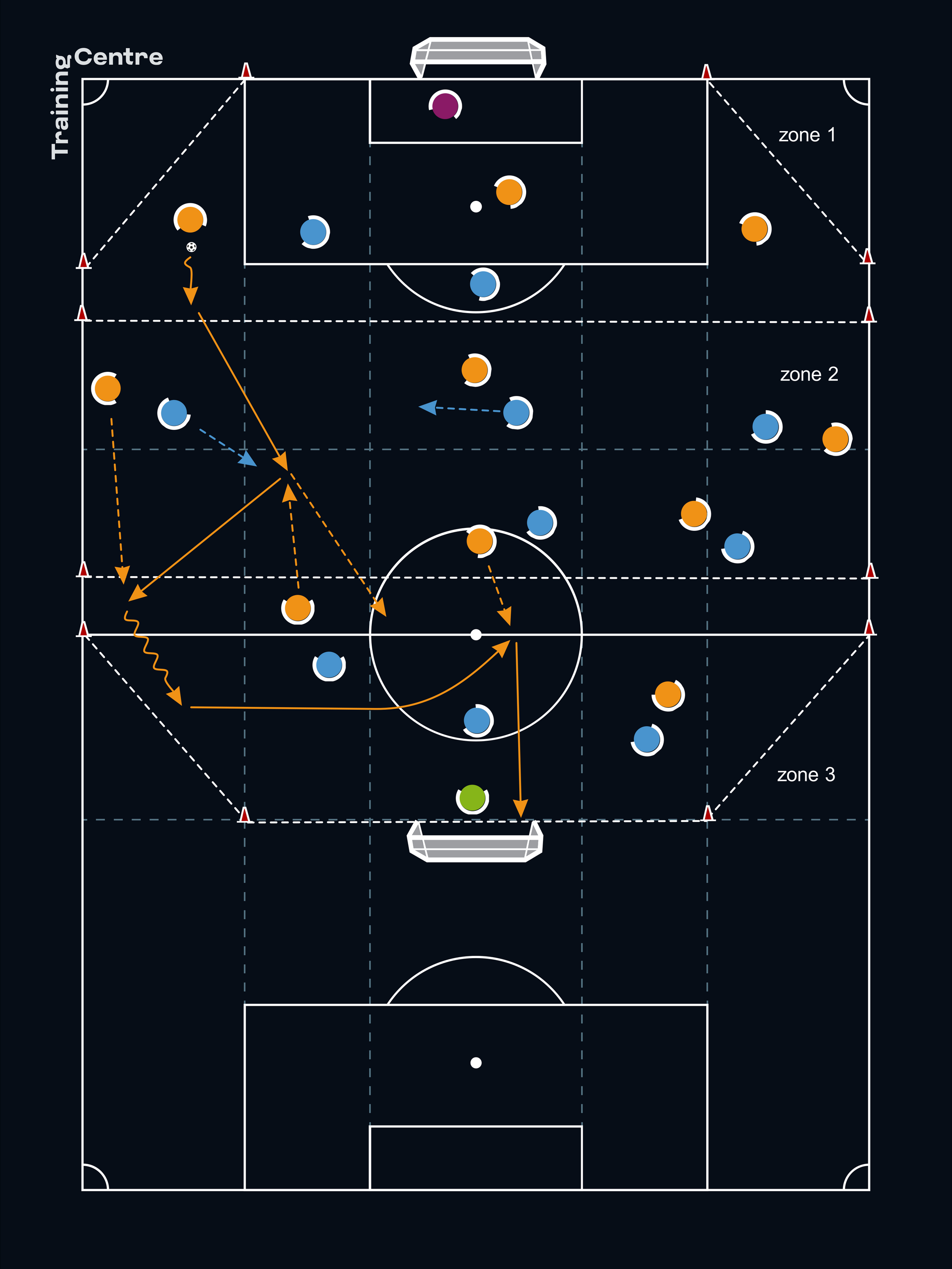
This game is intended to help players break through the lines by creating overloads and playing vertically into the final third. Through a complex game situation, players get plenty of opportunities to apply the patterns and team behaviour worked on in the previous exercises. The rules make it possible for additional players to overload the middle and final thirds so that the attacking team can find a free player more easily, making progression more straightforward.
-
Mark up an octagon-shaped pitch with a length of 65m and full width (in the middle section), and divide it into 3 zones with lengths of 20, 25 and 20m respectively.
-
11v11 including 2 goalkeepers.
-
Distribute 3 players on each team in their defensive third, 5 in the middle zone and 2 in the attacking zone.
-
The blue team starts with the ball in its defensive third and tries to progress towards the orange team's goal.
-
Passes from the defensive third are only allowed into the middle zone and not into the final third.
-
1 player from the attacking third is allowed to overload the middle zone to create a 6v5.
-
When the ball is played into the attacking third, 2 players from the middle zone can support the attack and create a 4v3 for the attacking team.
-
Despite the pressure created by the opposition, the team in possession must try to progress vertically up the pitch.
-
Players need to focus on their (re-)positioning, calling and offering for the ball and timing runs into the final third.
-
Once a vertical pass is played into the middle third, the team in possession must switch into a direct and attacking mindset. This mindset should be replicated in the passing patterns
-
By using combination play and overloading dangerous areas, teams can create more clear-cut chances.
-
There should be coordinated vertical movements and interactions between team-mates, with clear communication throughout.
-
The team in possession should break through the opposition's lines with precise and correctly weighted passes.
-
To increase the speed of passing sequences, well-timed movement when receiving a pass is crucial.
Part 4: 11v11 with turnover handicap
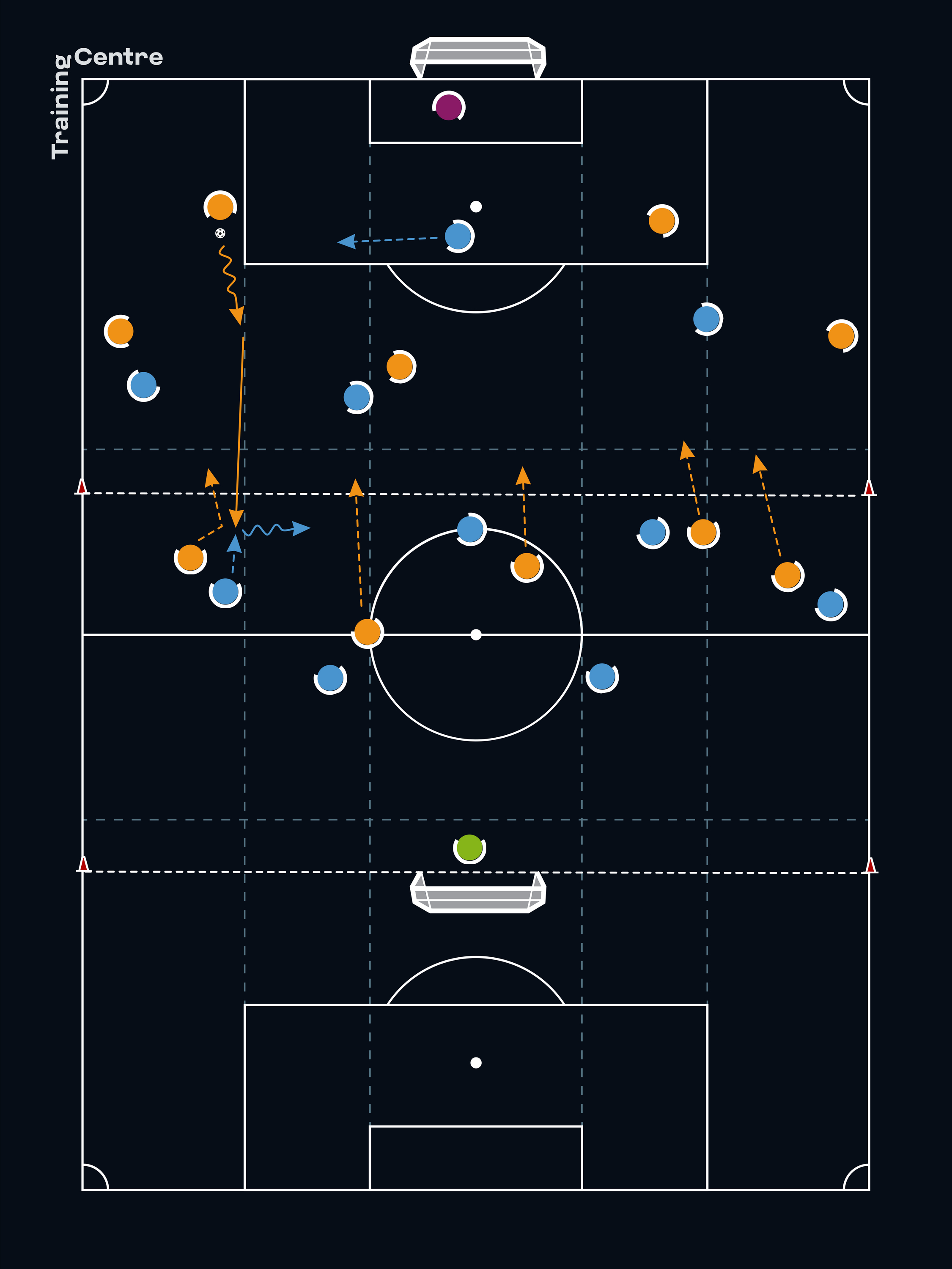
This game variation is similar to a normal match, but restricts the defensive team in certain game situations to make it easier to apply the attacking skills worked on previously. Main focus here is on vertical progressive play against a team defending in a low-block by playing forward and finding the deepest player.
-
Set up a pitch with full width and a length of 70m with a halfway line.
-
11v11.
-
As before, the attacking team tries to create chances and to score, with a strong emphasis on progressing vertically.
-
Different roles for the teams. One team is sprinting back into its half and starts defending from there, after the ball is lost. The other team is using counter pressing after losing possession.
-
The principles of the previous drills and the rhythm of the previous passing patterns should be applied to this freer 11v11 game.
-
Despite the pressure created by the opposition, the team in possession must try to progress vertically up the pitch.
-
There should be coordinated vertical movements and interactions between team-mates, with clear communication throughout.
-
Emphasis should be given to using vision to detect team-mates who are free, as well as always trying to play vertically.
-
Once a vertical pass is played from the backline into the midfield, the team in possession should progress the play with a direct and attacking mindset.
-
Players need to focus on their (re-)positioning, asking for the ball and timing runs into the final third.
-
Players should also create chances as a team through combination play and overloading dangerous areas.
-
The team in possession should break through the opposition's lines with precise and correctly weighted passes.
-
Movements to receive the ball have to be made at the right moment.
















